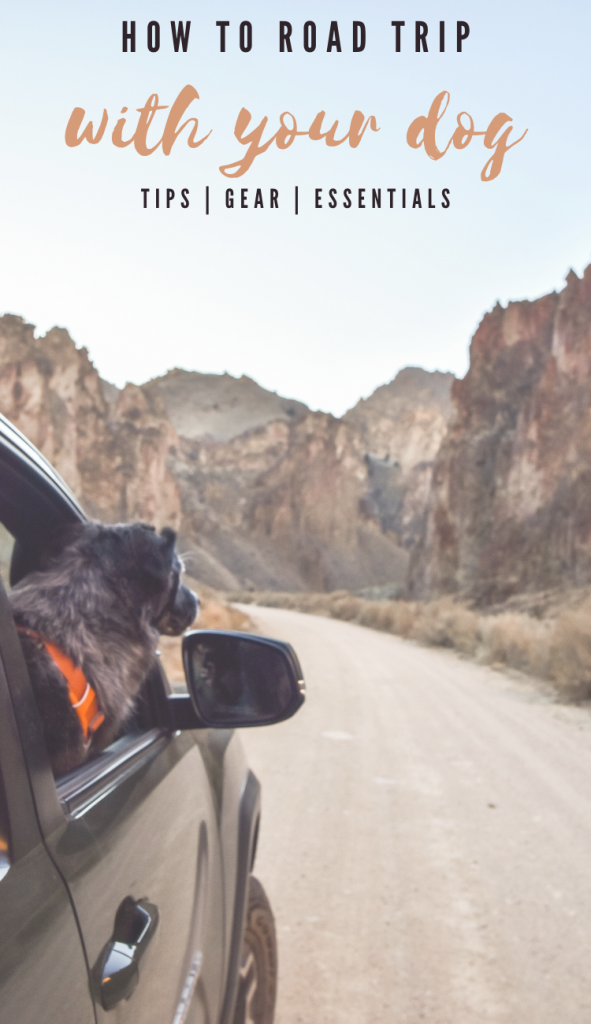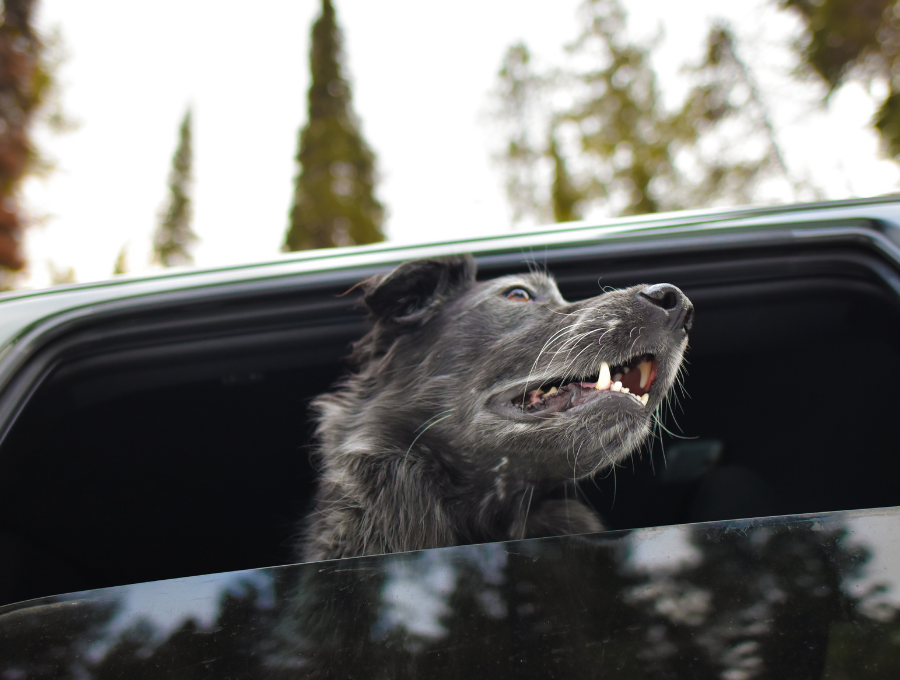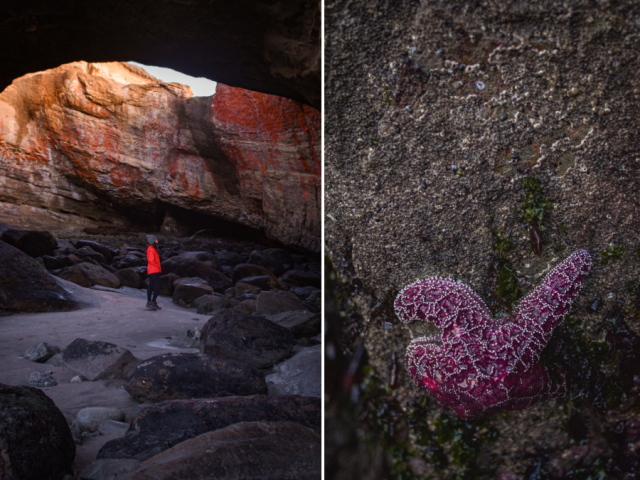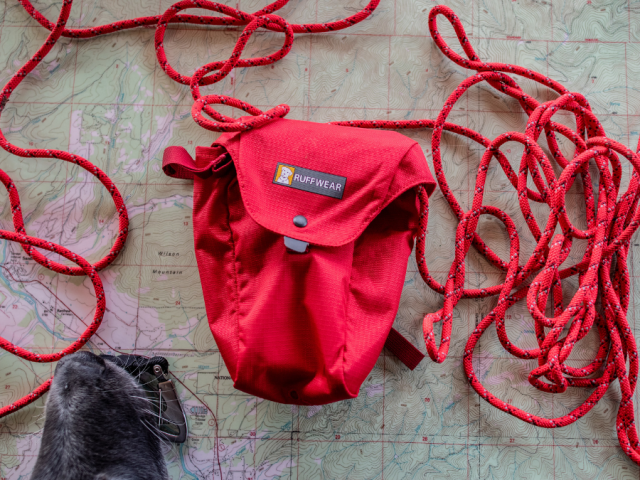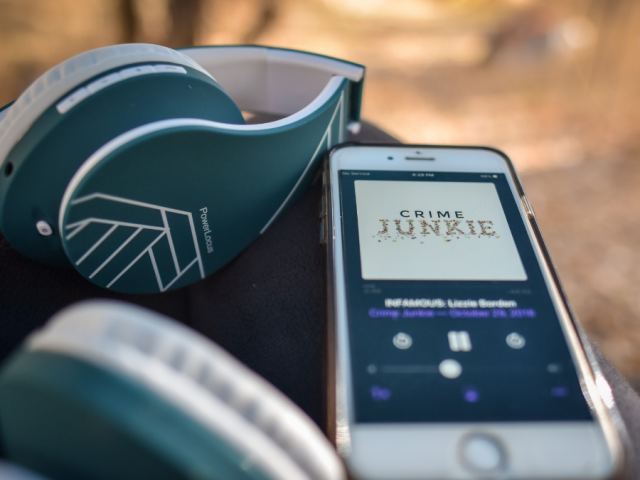We love our dogs so, naturally, we want to take them everywhere with us!
But taking your dog on a long-haul road trip is sometimes easier said than done. In theory, it sounds pretty idyllic. Just you and your furry friend, cruisin’ the highway – windows down, wind in your hair/fur, tunes blaring and nothing but scenic views and unlimited adventures to look forward to.
But alas… the reality of it looks quite different.
Ain’t that always the way?
In a lot of ways, traveling with a dog is almost like traveling with a kid [don’t come for me, parents]. More stuff to pack, more frequent pee breaks, and sometimes, more whining. The good news is, there’s plenty of things you can do to make your road trip more enjoyable – for both you and your dog.
Check out my top essentials [for humans] on long-haul road trips!
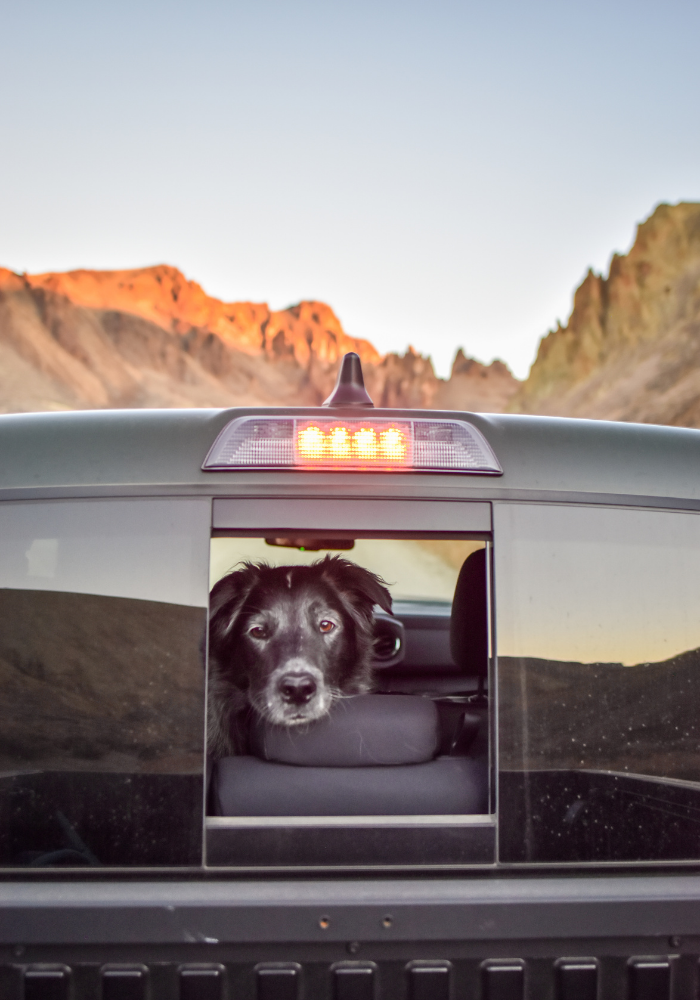
As I was writing and researching for this post, I realized there are A TON of frequently asked questions about road trips with dogs. So, in addition to my 2 core sections – road trip gear / essentials and tips – I’ve also included a section at the beginning for FAQs.
Let’s get to it!
AFFILIATE LINK DISCLOSURE: This post contains affiliate links. Anything you purchase using one of my links earns me a small monetary kickback at NO extra cost to you. Of course I only link to products that I believe to be useful and good quality. If you want more information on affiliate links, click here.
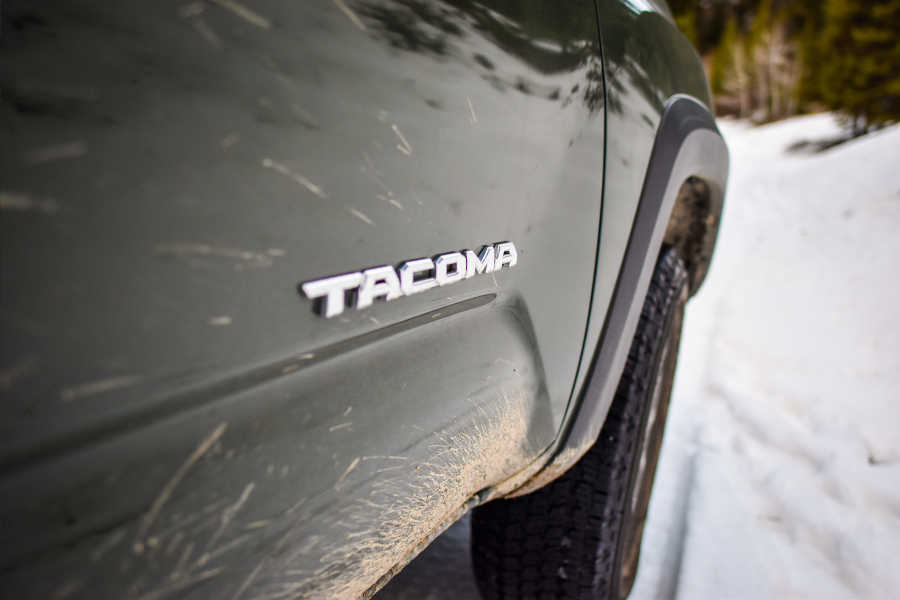
PUPPY ROAD TRIP FAQs:
HOW OFTEN SHOULD YOU STOP ON LONG ROAD TRIPS WITH DOGS?
Experts recommend you stop every 2 hours to let your dog stretch his legs and take a potty break. I know this seems way too frequent, but sitting still for that long is tough on your dog’s joints! It doesn’t need to be a particularly long stop, but this is kind of an unavoidable inconvenience when you’re on a road trip with your dog.
My advice? Take your dog for a quick walk every time you stop for gas or food and make good use of rest stops, too! Rest stops are right off the highway, easy to drive in and out of quickly, and usually have large grassy areas where you can walk and play with your pup.
CAN YOU USE BENADRYL AS A WAY TO CALM YOUR DOG IN THE CAR?
The short answer is no. Any medication that is not prescribed by your veterinarian is a no-go, but even if your vet has ok’d Benadryl to treat your pup’s allergies [which is common] you should not dose your dog with Benadryl for any other purposes unless you’ve consulted with a professional first. Dogs can die from overdoses of Benadryl and it is just not worth the risk.
MY PUP GETS ANXIETY IN THE CAR – WHAT CAN I GIVE MY DOG FOR STRESSFUL, LONG ROAD TRIPS?
If your dog has mild anxiety in the car, that’s completely normal, and there are a few different ways you can lessen the stress for your pup.
- Exercise! This is a big one. There is no better, more natural, or more safe method of de-stressing your dog than through exercise. Prior to your road trip, set aside 20 minutes to play fetch or some sort of higher-intensity exercise. This is our tried-and-true calming method with Tuna!
- Incentivize. Whatever your dog loves most [treats, toys, scratches] do those things, in excess, on your road trip! You want your dog to associate car rides with positivity.
- Work Up To It. Start your dog out on shorter trips or, depending on how severe the anxiety is, maybe even start out just sitting in the car for a minute or two. Easing into it is key for pups with travel anxiety!
- CBD Oil. Disclaimer – consult with your vet before giving CBD oil to your dog, always make sure you are dosing correctly and use CBD oil specific to pets [not humans! It’s not exactly interchangeable]. That being said, CBD oil has been pretty effective in treating Tuna’s anxiety but I did notice that the oil works better than the “CBD-infused” dog treats. I would recommend King Canine CBD since it is affordable, well reviewed and I have had nothing but good experiences using it.
- Thundershirt. This method isn’t for everyone – some dogs hate ’em, some dogs love ’em. But if your dog doesn’t mind wearing things like life jackets and costumes, a Thundershirt could be worth a try!
- A Piece of Your Clothing or Something From Home. As long as your dog doesn’t chew things he shouldn’t, something that smells like you [and your home] can be a super helpful calming tool on your road trip. If you have space for it in your car, bringing your dogs bed with you is another good option!
CAN MY DOG RIDE IN THE FRONT [PASSENGER] SEAT?
Short answer on this one: It is unfortunately not safe for your dog to ride in the front seat, even with a seatbelt. This is mostly because of airbags. If airbags were to deploy while your dog is sitting in the front seat, it would likely be a fatal impact.
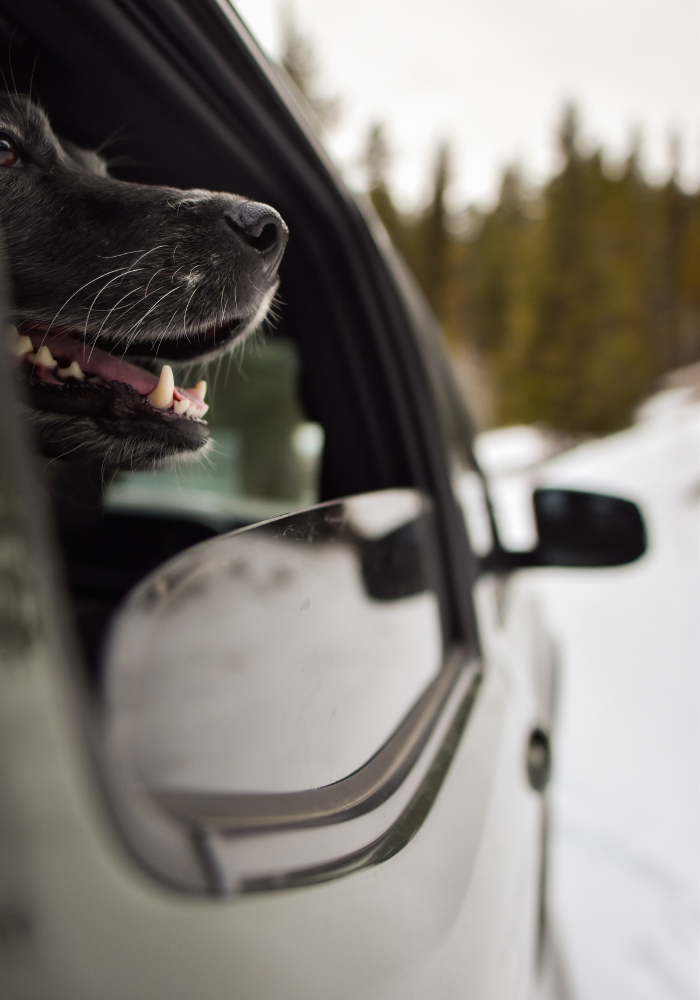
MUST-HAVE GEAR + ESSENTIALS:
1. FIRST AID KIT [FOR DOGS]
I use the Trail Dog First Aid Kit from Adventure Medical Kits. It’s small, lightweight and includes everything you need for your adventure pup:
- Tweezer / Tick remover
- Gauze, bandages and wraps
- Antiseptic wipes
- Alcohol swabs
- Triple antibiotic ointment
- Saline wound + eye wash
- Syringe
- Antihistamine
- Hydrogen Peroxide [used to induce vomiting if your dog eats something poisonous]
Note: You might be wondering why there is no snake bite kit included [or at least, I was] in this first aid kit. Well, apparently snake bite kits are almost completely useless for both humans and dogs. Who knew!? Snake bite kits usually contain a suction device [to extract venom], a scalpel [to cut around the bite wound] and a constriction band [to slow the spread of venom]. None of these methods are effective and veterinarians advise strongly against all of them, as they can ultimately end up causing more damage to your dog. Your best bet is to keep the wound below heart level, keep your dog as calm as possible, call the nearest emergency vet to let them know you are coming in and will need anti-venom, and move as quickly and safely as possible.
2. COLLAPSIBLE BOWL [AND PLENTY OF FOOD + WATER!]
I really like this collapsible bowl from Ruffwear! It’s large, folds flat, and it’s also deep enough and stable enough [due to the square base] that I can actually give Tuna water while we’re driving. Super handy!
Which brings us to water: your dog will likely be drinking more than usual on your road trip [so pack more than you think you’ll need!]. Most dogs have at least slight car anxiety, or at the very least they get excited in the car. An excited dog means more panting, and more panting means more water is needed. Yet another reason that you’ll need to make more frequent pee stops.
As far as food goes, packing enough of it may not seem like a huge deal – after all, you can always find a grocery store if you run out. However you may not be able to find your usual brand of dog food, and the combination of travel stress and introducing new food could be a recipe for disaster! You want to keep things as consistent as possible for your dog, since there’s enough change happening already on your road trip.
3. TREATS
You want to make the road trip experience as enjoyable as possible for your dog. What better way to do that than with treats!?
As I’ve discussed before, treats are a great way to incentivize being in the car and help your dog associate car rides with yummy goodness.
4. TOYS
Maybe your dog won’t play with toys in the car [or maybe you don’t want him/her to] but you’ll need some toys for your road trip pit-stops and for when you [finally] arrive at your destination.
Tuna is a heaaavy chewer [I can’t leave him alone with regular dog toys for more than 30 seconds without them being destroyed]. Only 2 brands have withstood the wrath of Tuna’s scissorteeth – Kong and Ruffwear. And even with those brands, only the rubber toys will do. My recommendations for tough chewers are as follows:
- The Original Kong
- The Kong Squeezz Ball With Squeaker [Tuna loves this one!]
- The Ruffwear Huck-a-Cone [just don’t let them chew the rope!]
- The Ruffwear Gnawt-a-Rock Treat Dispenser Toy
5. SEAT COVER
This isn’t absolutely essential, but it can make your road trip WAY less stressful. A seat cover will allow you to go on real adventures with your dog without the worry of damaging your upholstery [and trust me, towels just don’t cut it].
If you’re looking for a recommendation, we absolutely LOVE our Ruffwear Dirtbag Seat Cover [found here on their website, with free shipping!]. It’s definitely worth the extra money for a quality seat cover, especially if you have a big dog like I do. I’ve had a couple friends who opted for a cheaper cover and it couldn’t hold their dogs weight. The straps ended up breaking and it needed to be replaced. The Ruffwear cover is super durable. I have a 70 lb dog who uses this cover as a hammock [meaning he lays in down on the portion that’s hanging over the floor, unsupported] and it has held up great! It’s also waterproof, has a large zip pocket to store goodies in, and covers the ENTIRE seat [there are flaps that hang down over the sides, so every inch of your backseat is protected].
NOTE: It is also compatible with doggy seatbelts! [See #9]
6. FLEA + TICK SPRAY
This is a must-have for adventure dogs! I spray Tuna with it before every hike and every camping trip. I’m convinced that it works! The one time I forgot to reapply it [after Tuna took a swim in a nearby river] I found a nasty little tick in his fur. Yuck!
7. WET WIPES
Wet wipes are a must when traveling with dogs! Whether you’re cleaning up slobber, mud, or some strange unknown substance – you’re gonna be cleaning and you’re gonna want wet wipes!
8. POOP BAGS!
I get it – nobody wants to pick up poop. But it’s so important for more reasons than one! Dog poop can pollute our waterways, introduce foreign bacteria to new areas, and it’s just stinky/unsightly for other visitors. Make sure you bring a big stash of poop bags on your trip and always, always pick up after your pet!
9. DOGGY SEATBELT
I know it’s not the most comfortable thing for your pup to wear, but accidents do happen, and a loose dog during an accident is extremely dangerous. A doggy seatbelt is a hassle, but it can prevent a tragic loss. If you’re anything like me your dog is your baby and, while I feel bad putting something restrictive on him, I know I’d feel worse if something bad were ever to happen.
PRO TIP: Make sure that there’s enough slack in the leash that your dog can move around a little bit, but not so much that he’ll get tangled up.
10. DOG HARNESS + LEASH
A harness is a great alternative to dog collars – especially for road trips! Collars are not only more dangerous than harnesses, they’re also much less comfortable [especially if you’re hooking your dog up to a seatbelt]. Another bonus to using harnesses rather than collars: They are easier to grab + hook up to a leash in a hurry when you’re on-trail. I use the Flagline Harness from Ruffwear, but there are so many great harnesses to choose from!
If you’re looking for a recommendation on leashes, I can’t say enough good things about the Ruffwear Knot-a-Leash [and no, I am not sponsored by Ruffwear – just mildly obsessed with their products]. This leash has been a lifesaver for us. Tuna pulls harder than, I’m convinced, any other dog in existence and he has snapped multiple leashes. The Ruffwear Knot-a-Leash is made of thick, climbing-inspired rope and has a locking carabiner that attaches to your pup’s collar or harness – it’s probably the most durable leash on the market!
NOTE: If you’re planning on camping on your road trip, check out my camping essentials for dogs!
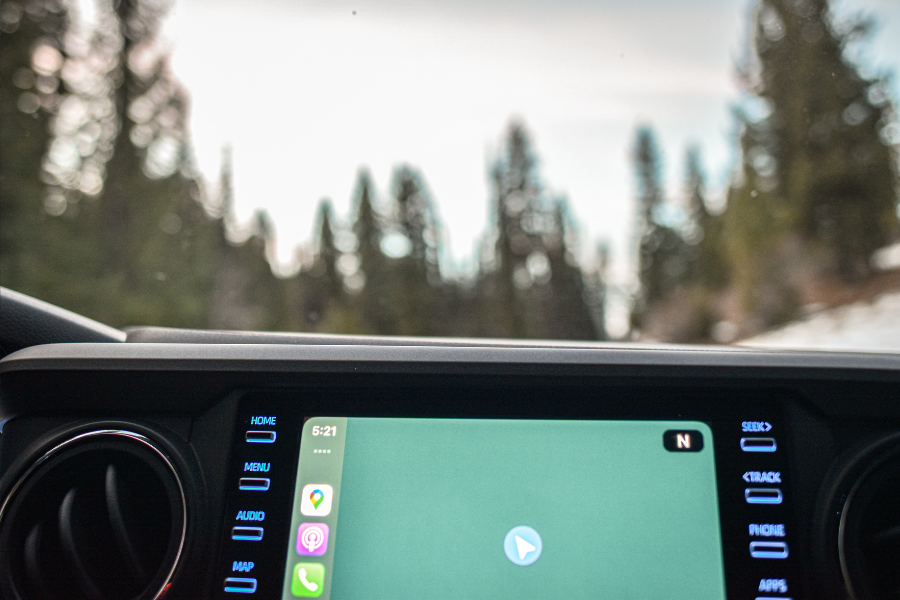
TIPS FOR A COMFY, SAFE + STRESS-FREE ROAD TRIP WITH YOUR DOG:
1. RESEARCH YOUR DESTINATION(S) BEFORE YOU LEAVE
Is your hotel pet friendly?
How about that hike you’re planning on going on?
Are you visiting a National Park? NOTE: Most of them don’t allow dogs on trails or near lakes/rivers 🙁
When you’re traveling with a dog, you have to do a little extra planning. We’ve come a long way as far as dog-friendliness, but many places still have rules against them – or at the very least, restrictions. Make sure all of your planned activities are dog friendly and that you’re aware of any relevant leash laws!
2. PREP YOUR DOCUMENTS + TAGS
Make sure your tags and chip information are up-to-date in case your dog somehow gets loose! You want your information readily available to whoever finds your dog so he/she can be safely returned to you.
Also, be sure to pack your dog’s medical documents in case there’s an emergency and you need to either board your dog or take him to a veterinarian while you’re away from home.
3. CREATE A COMFORTABLE SPACE FOR YOUR DOG [WITH SOME FAMILIAR BELONGINGS]
Create a designated space for your dog and keep his needs in mind. Some things to consider when choosing a space for your dog:
- Window access. Most dogs enjoy being able to look out the window, and it makes car-sickness less likely.
- Adequate space. Make sure there’s enough space that your dog can change positions and stretch his legs. I usually clear the entire backseat and most of the floor in front of the back seat.
- Familiar items/toys. As long as your dog doesn’t chew on clothes/blankets, it can be helpful to include some familiar things from home for him to snuggle-up with. That can be a shirt [that smells like you], a dog bed or blankets/toys that your dog uses at home. Things that smell like home can be soothing to your pup and reduce stress on long road trips.
4. DOUBLE DOWN ON WATER
Make sure you have more than enough water for both you and your dog. Hydrating is super important, especially on road trips. It’ll help prevent headaches and the dreaded “post-vacation sickness”, and it’ll also keep your pup comfortable and content. Keep in mind, dogs are just as at risk as we are for dehydration! Make sure your dog has access to water whenever he wants or needs it.
5. GIVE YOUR PUP PLENTY OF TREATS + REWARD GOOD BEHAVIOR
You want to make car rides a “happy place” for your dog, so make sure you incentivize road trips! Give your pup a treat every time he gets in the car on his own [or after you put him inside if he can’t, or won’t, get in by himself] and it doesn’t hurt to give him the odd treat throughout the trip, too!
6. TAKE FREQUENT POTTY BREAKS
Experts recommend every 2 hours, which sounds like a LOT, but it’s more than just for potty breaks – it’s to stretch their legs, too. Dogs aren’t used to sitting/laying down for hours on end. Even when they’re just lounging about at home, they’ll get up and move every once in a while. Even just a quick stop on the side of the road is better than nothing at all!
PRO TIP: Try taking advantage of rest stops since they are easier and faster to pull off to than gas station/restaurant stops and usually have large, grassy areas where you can walk your dog.
7. TAKE TIME TO PLAY!
If you can find a quiet place away from the road [BLM land is preferable] or, even better, a nearby dog park – take 5 minutes to play fetch or tug-of-war with your dog! Your dog needs to stretch his legs and likely has a ton of built-up energy to blow off. Sometimes, if I can’t find a place that allows for off-leash play, I’ll just go for a quick jog around the rest stop area. [Emphasis on “quick” since I’m super out-of-shape and also don’t want to be sweaty for the remainder of the car trip].
8. KEEP IT COOL + NEVER LEAVE YOUR DOG IN A HOT CAR!
What’s cool for you may not be cool for your dog [who is covered in at least one layer, if not two, of fur]. Pack a warm sweater so you can keep the car cool and comfortable for your pup without freezing yourself!
And on that note, take extra care not to leave your dog unattended in the car. If you’re traveling with a friend or family member it should be easy to keep an eye on your dog. At rest stops, have one person walk the dog while the other goes to the bathroom and then swap out! Two birds, one stone.
If you’re traveling alone, however, try to park in the shade [on hot days] and keep your bathroom breaks as short as possible. Temperatures as low as 70 degrees can become dangerously hot for dogs inside of a car. Lower temperatures can be dangerous too, as they put dogs at risk of hypothermia.
NOTE: If your car doesn’t have tinted windows, it might be worth purchasing UV shades! They’re pretty inexpensive and they are super easy to put up and take down.
9. SCOUT OUT THE LOCAL DOG PARK
When you arrive at your destination, do a quick search and see if there’s a dog park near you! Dog parks are a great place for your dog to unwind and expel some pent-up energy after a long road trip.
10. DON’T LEAVE YOUR DOG BEHIND
Leaving your dog alone in your hotel room is not really an option while you’re on vacation. Not only do most hotels have a policy against this, it’s just not safe. Your dog is in an unfamiliar environment and a lot of things could go wrong. Even if your dog is not a chewer naturally, you don’t know how they’ll react in a stressful situation. You don’t want to risk having to pay damages or, worst case scenario, have your dog choke on something while you’re away.
But what if the hotel allows it and you leave your dog in a crate? This is a safer option, but I would still strongly advise against it. Your dog will be stressed out the entire time and, if you can’t bring your dog with you on your vacation activities, boarding is probably a better option for you. I know how expensive dog boarding can be, but it’s something that has to be factored in to your vacation budget if you want to do non-dog-friendly activities. We all love our dogs and want to bring them along for the trip, but sometimes boarding them is the best option – that way they get frequent play time, socialization with other dogs, and have someone monitoring them and making sure they stay safe, fed and hydrated.
Which brings me back to Tip #1: Research your destination! If you’re set on taking your dog on a road trip, make sure all your activities are dog friendly. Your hotels, your hikes, your restaurants, etc. Don’t create a situation where your dog is left out and has to either sit in the car unattended or in a hotel room by himself. It’s not fair to your dog and it can be avoided with a little pre-planning.

Going on a road trip with your dog? Have any more questions/thoughts? Tuna and I are here for ya! Drop your Q’s in the comments or send me a message!
PIN IT FOR LATER!
